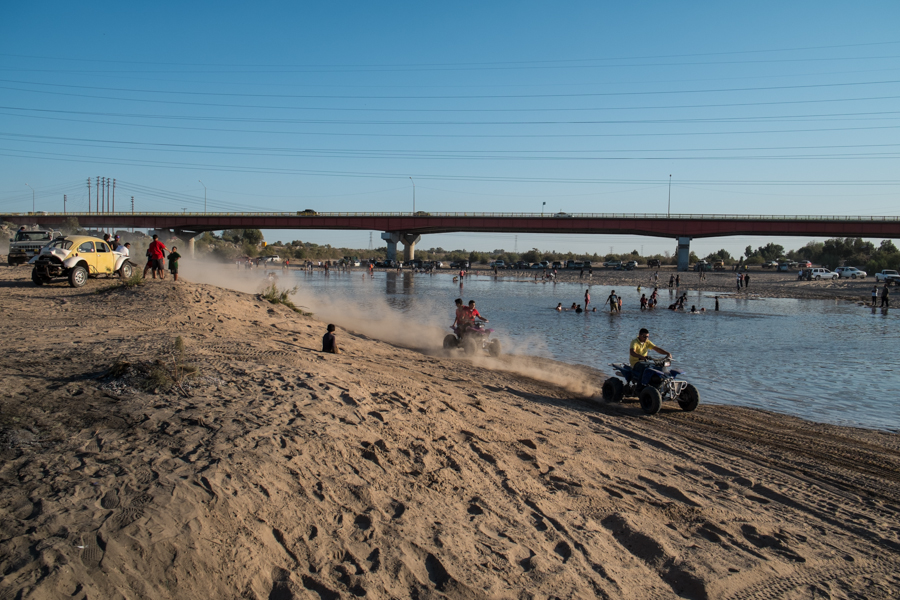When I set up a Google News alert some years ago on the words “Colorado River”, I noticed a revealing pattern. In spring, as the weather warmed, the water management and drought news I was hoping for was increasingly mixed with stories of drunk people drowning in the river. In the fall the mix of drunks and other ill-advised recreationists tapered off.
When I was a kid growing up in the upper middle class suburbs of LA in the 1960s and ’70s, friends would take off in their campers, towing boats, for a weekend at “the river”. In his epic book A River No More, Philip Fradkin describes the “Parker Strip”, the stretch between Parker and Headgate dams on the Arizona-California border:
It is the river as theater, where each of the 125,000 weekend visitors compressed into the fourteen miles, and huddled as close as possible to the cool water, can act. To be a protagonist, rather than part of the supporting cast, one needs a sleek water-ski boat in the shape of a tapered arrowhead and powered by a jumble of chrome.
There was beer – “a million cans … can be consumed in one long holiday weekend” – and the throbbing of a disco beat at waterside taverns. “The Colorado is a charnel river at this point,” Fradkin wrote.
He tells the sad story of attempting a kayak trip with a friend from a place called Walter’s Camp, south of Blythe on the Lower Colorado, midway between the Parker Strip and the river’s end at Morelos Dam. Their attempt at a quiet paddle through exquisite desert (I know this, having paddled that stretch myself) was ruined by some three hundred motorboats in the Blythe Boat Club’s annual river regatta. It’s easy to feel sympathy for Fradkin and his friend when a water skier zooms close and sends a sheet of river water over the kayaking pair. But implicit in his argument is something that’s problematic in negotiating the terrain of Colorado River management in the 21st century.
Fradkin calls the Parker Strip “a charnel river” – a death house. But his description of the pulsing humanity is anything but. It’s alive, just with people doing things of which Fradkin disapproves. 125,000 people with their RV’s and motorboats and beer were embracing the river, just with a different set of values than Fradkin’s. This is a hard problem, because there is no a priori value for the Colorado or any river, but we get tangled up in groups who hold each set of values assuming theirs is the right one. We want it as a water supply for our farms and cities, and as a haven for motorboats, and as a place for a quiet kayak, and as a living river that is its own intrinsic value separate from the way humans might choose to use it. There’s conflict among those values, because we can’t have them all simultaneously, and Fradkin is pissy because his values have long been on the losing side.
As a child of the Sierra Club who paddled the river rather than motorboated as a youngster, my cultural sympathies long aligned with Fradkin’s. But here’s the thing I think he gets wrong. When I was a teenager, my Boy Scout troop canoed the same stretch of the river, past Walter’s Camp. It was 1973, around the same time as Fradkin’s ill-fated voyage. It was a quiet delight. But I understand now that the “river” we rode wasn’t really a river at all, but rather a water supply delivery system using the old river’s channel. The “thin veil of vegetation” along the riverside that Fradkin celebrates as he describes the river’s beauty there is really a vestige of the river’s management – what was left to grow after the spring floods were cut down by Hoover Dam to the north. It’s lovely, but ecologically and environmentally, it’s a mess. It’s not a river in any Platonic sense, but rather a human construct. Fradkin simply prefers his construct to theirs.
I took Fradkin along as my trip book last month when I went down to the delta to cover the release of the environmental pulse flow from Morelos Dam. The reason I’m so interested in the pulse flow experiment is because of the way Minute 319, the international agreement that made it possible, attempts to find some sort of common ground spanning the different value systems we have for the river. The deal has a complex mix of farm water and urban water and water for the environment, and nobody got all of what they wanted but the deal recognizes that no one set of values is right, and no one interest group can simply muscle its way to the front of the line.
And then at San Luis Río Colorado, as the border community saw substantial water flow through the usually dry river for which their town is named, I saw a remarkable spontaneous party emerge. There were environmentalists from the United States and Mexico, and scientists, and bureaucrats from the U.S. Bureau of Reclamation, and townsfolk drinking beer and tearing up and down the river’s edge in their four-wheelers. And everybody seemed happy to share the river. There was no one right way.


Pingback: Bloggers on groundwater management: One size fits all? Or a politically created emergency? Plus bloggers on Feinstein’s bill, ag use, fracking, and more … » MAVEN'S NOTEBOOK | MAVEN'S NOTEBOOK
Pingback: “half-told stories about the value of water” | jfleck at inkstain